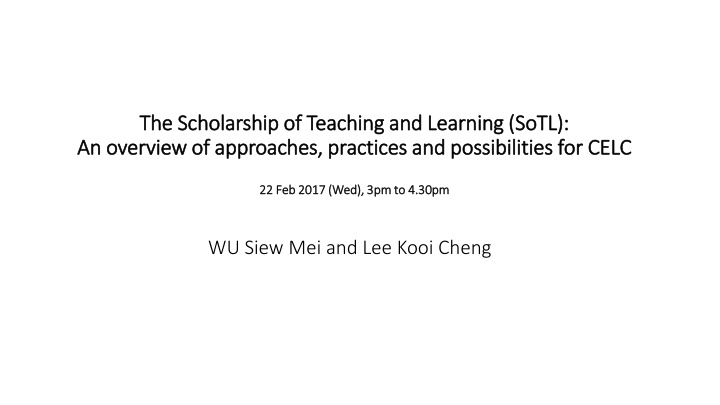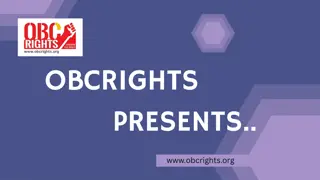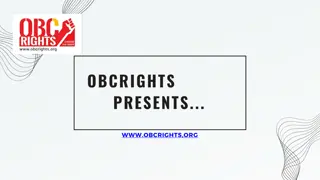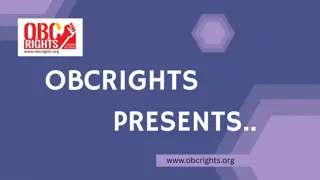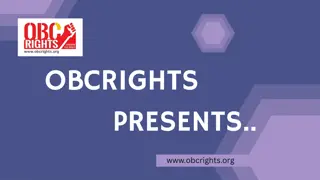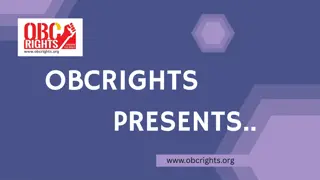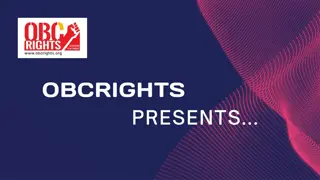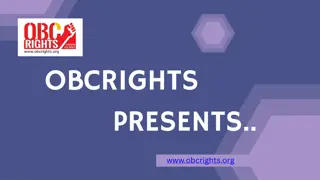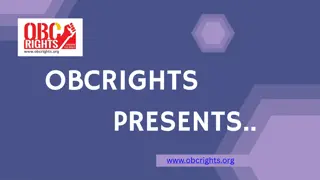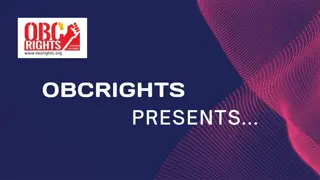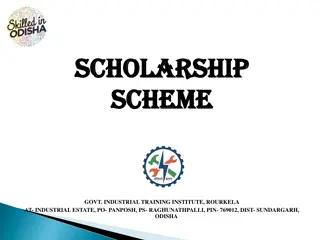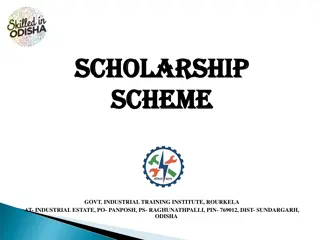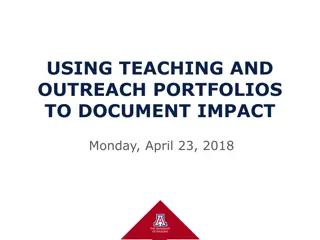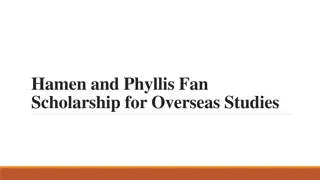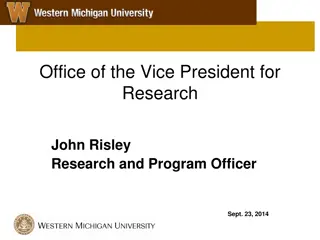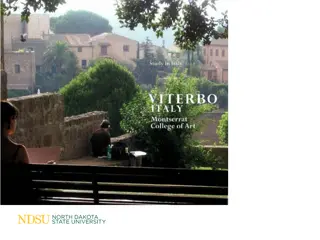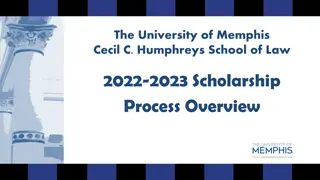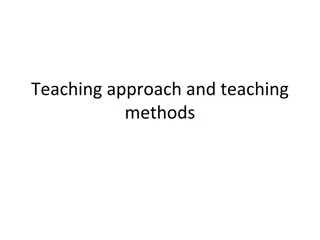The Scholarship of Teaching and Learning: Approaches, Practices, and Opportunities
In this overview, explore the Scholarship of Teaching and Learning (SoTL) focusing on methodology, publication concerns, and sample investigations at CLEC. Understand how SoTL impacts teaching activities and improves student learning outcomes through scholarly communication. Discover the importance of systematic observation and the design of effective teaching experiences in higher education.
Download Presentation

Please find below an Image/Link to download the presentation.
The content on the website is provided AS IS for your information and personal use only. It may not be sold, licensed, or shared on other websites without obtaining consent from the author.If you encounter any issues during the download, it is possible that the publisher has removed the file from their server.
You are allowed to download the files provided on this website for personal or commercial use, subject to the condition that they are used lawfully. All files are the property of their respective owners.
The content on the website is provided AS IS for your information and personal use only. It may not be sold, licensed, or shared on other websites without obtaining consent from the author.
E N D
Presentation Transcript
The Scholarship of Teaching and Learning ( The Scholarship of Teaching and Learning (SoTL An overview of approaches, practices and possibilities for overview of approaches, practices and possibilities for CELC SoTL): ): An CELC 22 22 Feb 2017 (Wed), 3pm to 4.30pm Feb 2017 (Wed), 3pm to 4.30pm WU Siew Mei and Lee Kooi Cheng
Agenda 1. SoTL and what it means to CELC a. SoTL: An overview b. Methodology and methods c. Publication concerns and platforms d. Problems and opportunities for investigation at CELC 2.Samples of SoTL investigations at CELC a. Misty Cook Scholarly Reflection on English for Academic Purposes b. Radhika Jaidev Scholarly Reflection on the revamp of Graduate English Courses c. KC Lee SIG as a scholarly practice? 3.Small group discussions and sharing on potential SoTL inquiries
Scholarly Teaching (ST) Scholarly Teaching (ST) Scholarship of Teaching and Learning ( Scholarship of Teaching and Learning (SoTL SoTL) ) to impact the activity of teaching and the teaching results in a formal, peer- resulting student learning; a scholarly reviewed communication in an process that depends on systematic on systematic appropriate medium or venue, which observation observation of the effects of the effects of teaching on then becomes part of the learning knowledge base of teaching and learning knowledge base of teaching and learning in higher education in higher education (Witman & Richlin, 2007)
Scholarly Teaching (ST) Scholarly Teaching (ST) begins with an observation, which identifies a situation the instructor would like to improve improve, or an opportunity opportunity the instructor would like to seize (Richlin, 1993, 1998, 2001, 2003) to document a baseline baselineof activity; to study what others have done
design of teaching experiences that have the best chance of helping students achieve the course learning objectives. selection of method must be justified from what is known in the literature. It must be made explicit. application of the new method must be observed and recorded in a systematic way.
materials and reflections collected from observation and student work should be systematically documented in a course portfolio, followed by reflection and analysis of the results (Richlin & Manning, 1995). assessment of the course focused on student achievement of learning objectives. comparison of the results to the baseline, to see whether or not the new method resulted in an improvement in student learning.
application of new knowledge about teaching and learning to the professors future courses is the end product of scholarly teaching.
Scholarship of Teaching and Learning ( Scholarship of Teaching and Learning (SoTL SoTL) ) SoTL process involves composing selected portions of the scholarly investigations and findings into a manuscript to be submitted to an appropriate journal or conference venue. Peer review of the manuscript or presentation proposal, by experts in both the discipline and the methods used, is necessary, just as it is in disciplinary scholarship. If accepted for publication or presentation, the results and conclusions enter the knowledge base for others to consult for their teaching challenges.
Agenda 1. SoTL and what it means to CELC a. SoTL: An overview b. Methodology and methods c. Publication concerns and platforms d. Problems and opportunities for investigation at CELC 2.Samples of SoTL investigations at CELC a. Misty Cook Scholarly Reflection on English for Academic Purposes b. Radhika Jaidev Scholarly Reflection on the revamp of Graduate English Courses c. KC Lee SIG as a scholarly practice? 3.Small group discussions and sharing on potential SoTL inquiries
Scholarly Teaching in practice Scholarly Teaching in practice Two sample reflections Two sample reflections Investigating teaching practices 1. 2. Dr Misty Cook English for Academic Purposes Dr Radhika Jaidev Graduate English Course
Agenda 1. SoTL and what it means to CELC a. SoTL: An overview b. Methodology and methods c. Publication concerns and platforms d. Problems and opportunities for investigation at CELC 2.Samples of SoTL investigations at CELC a. Misty Cook Scholarly Reflection on English for Academic Purposes b. Radhika Jaidev Scholarly Reflection on the revamp of Graduate English Courses c. KC Lee SIG as a scholarly practice? 3.Small group discussions and sharing on potential SoTL inquiries
Possible problems and opportunities for investigation for CELC Possible problems and opportunities for investigation for CELC SIG/SIT as scholarly practice? Other Special Interest Groups/Teams
SIG/SIT as a scholarly practice SIG/SIT as a scholarly practice Purposes To share readings (i.e., underpinnings) and critically reflect on readings vis a vis what we do in and for our class (i.e., practice) To create an interactive space (both e- and f2f) for the curation, sharing and conversation on insights, reflections, thought-provoking ideas, new ways and thoughts Networked improvement community + community of practice ( Networked improvement community + community of practice (Bryk Bryk, 2016) , 2016) SoTL SoTL to be part of institutional culture (Williams et al, 2013) to be part of institutional culture (Williams et al, 2013)
SIG/SIT as a scholarly practice SIG/SIT as a scholarly practice For SoTL to be successfully integrated into organizational culture 1) effective communication and dissemination at all levels 2) well established social networks across all levels 3) sustained support by upper management (Williams et al, 2013) Grassroots SoTL leadership, tempered radicals (Kezar et al, 2011) Networked improvement Networked improvement community community + + community community of practice ( of practice (Bryk Bryk, 2016) , 2016)
SIG/SIT as a scholarly practice SIG/SIT as a scholarly practice Approach do a thorough literature scan in the use of the flipped/blended approach, in general and more specifically in ELT collaborate with the NUS Libraries for the curation of resources and CIT for an e-platform for interaction (e.g., https://teamup.nus.edu.sg) engage colleagues from other departments in sharing best practices critically reflect on how materials are presented, how assessments are done, how activities are designed to engage students, the extent to which the approach has/hasn t had an impact on student learning, and the kind of impact the approach has on engaged teaching explore innovative ways in strengthening the flipped/blended pedagogy make (informed) changes for an enhanced achievement of intended learning outcomes Scholarly teaching Scholarly teaching SoTL SoTL p publish and share with wider community ublish and share with wider community a apply + document new knowledge pply + document new knowledge
Agenda 1. SoTL and what it means to CELC a. SoTL: An overview b. Methodology and methods c. Publication concerns and platforms d. Problems and opportunities for investigation at CELC 2.Samples of SoTL investigations at CELC a. Misty Cook Scholarly Reflection on English for Academic Purposes b. Radhika Jaidev Scholarly Reflection on the revamp of Graduate English Courses c. KC Lee SIG as a scholarly practice? 3.Small group discussions and sharing on potential SoTL inquiries
Agenda 1. SoTL and what it means to CELC a. SoTL: An overview b. Methodology and methods c. Publication concerns and platforms d. Problems and opportunities for investigation at CELC 2.Samples of SoTL investigations at CELC a. Misty Cook Scholarly Reflection on English for Academic Purposes b. Radhika Jaidev Scholarly Reflection on the revamp of Graduate English Courses c. KC Lee SIG as a scholarly practice? 3.Small group discussions and sharing on potential SoTL inquiries
SoTL SoTL research research Research has taught us that successful organizations reflect on their practice (See Bok, 2006). For educational organizations, this means researching the ways their students learn and their faculty teach. All institutions can generate similar research questions addressing such topics as learning processes, signature pedagogies, online interaction processes and dynamics, program scope (gauging the short- and long-term of impact), effective learning environments, and faculty support and relations. To maximize this benefit, it is recommended that a comprehensive research agenda be created and that this agenda be closely aligned with university mission and vision statements. Too little institutional research addresses pedagogy. Even less likely is a strategic partnering of individual faculty researchers and staff working in an office of institutional research. Poole, 2007
Challenges and issues Challenges and issues Major research design Major research design: : One common approach to this sort of research is to measure relevant aspects of what the students are learning, make a change or introduce a new method or assignment, and then measure students' learning again to determine the extent to which the manipulation affected it (see Gurung & Schwartz, 2009, for exemplars of conducting SoTL research). Gurung & Ericlandrum, 2012
Challenges and issues Measuring learning student learning outcome
Challenges and issues Challenges and issues Learning theories and frameworks - Vanderbilt University Centre for Teaching and Learning https://cft.vanderbilt.edu/teaching-guides/principles-and-frameworks/ Miller-Young, J. & Yeo, M. (2015). Conceptualizing and Communicating SoTL: A Framework for the Field Teaching and Learning Inquiry: The ISSOTL Journal, Volume 3, Issue 2, 2015, pp. 37-53.
Conceptualizing and Communicating SoTL: A Framework for the Field ABSTRACT The emerging field of SoTL is an inherently interdisciplinary endeavor which requires embracing a diverse range of research methods and disciplinary differences in world views. This diversity has caused a lack of coherence in its conceptualization and communication, which can be confusing for new scholars. Ongoing debates in the community concern the use of theory and methodology, as well as definitional questions of what constitutes SoTL and the nature of its purpose. This article offers a framework for conceptualizing the field which attempts to broadly delineate the available learning theories underlying and methodologies appropriate to studying teaching and learning, while intending to be hospitable to a broad range of diverse disciplines. Further, the framework illustrates the tacit links between learning theories and methodologies, serving as a guide to potential approaches to SoTL work. The framework is illustrated with example SoTL studies. It is hoped that the framework will help ground future SoTL investigations in appropriate theories and methodologies, and build interdisciplinary communication and understanding in the trading zone that is SoTL.
How learning works: 7 research based principles for smart teaching Susan Ambrose, Michael W. Bridges, Michele Di Pietro, Marsha C. Lovett, Marie K. Norman, Richard E. Mayer, 2010. Wiley: USA
Challenges and issues Challenges and issues Engagement with statistics Bartsch, R. A. (2013). Designing SoTL Studies Part I: Validity New Directions for Teaching and Learning. 136, winter. Pp. 17 33. Bartsch, R. A. (2013). Designing SoTL Studies Part II: Practicality New Directions for Teaching and Learning. 136, winter. Pp. 35 48. Wilson-Doenges, G. (2013). Statistical Models for Analyzing Learning Data. New Directions for Teaching and Learning. 136, winter. Pp. 49 58.
Challenges and issues Challenges and issues Linking the bottom up investigative effort to the publicly disseminated conference paper / journal publication Observations from a range of abstracts Transcending course level boundaries Transcending centre level concerns Collaborative effort across a team or teams from different faculties Extending issues beyond specific English language teaching concerns Situating issues in frameworks, principles and rationales relevant to tertiary level teaching and learning literature
Platforms for publication Research in the Teaching of English Research in the Teaching of English. Urbana, IL: NCTE (Pub.). Published by the NCTE, this journal has a reputation for advancing the SoTL. This journal of original research is multidisciplinary, and promotes the teaching and learning of language at all levels. http://www.ncte.org/pubs/journals/rte Teaching English in the Two Teaching English in the Two- -Year College Year College. Urbana, IL: NCTE (Pub.). TETYC is published by the NCTE for instructors of English in two-year colleges as well as for teachers of first- and second-year composition in four-year institutions. TETYC has embraced the SoTL and occasionally publishes the SoTL articles. http://www.ncte.org/pubs/journals/tetyc College English College English. Urbana, IL: NCTE (Pub.). College English is also published by the NCTE and is the professional journal for the college scholar-teacher. It is noted for its occasional promotion of the SoTL agenda. http://www.ncte.org/pubs/journals/ce PMLA. New York, NY. Modern Language Association (Pub.). This official journal of the Modern Language Association publishes essays and articles for many language and literary disciplines. It occasionally publishes the SoTL articles. http://www.mla.org/pmla College Composition and Communication College Composition and Communication. Urbana, IL. NCTE (Pub.). In its beginning, CCC, another publication of the NCTE, was meant to be an extension of College English. Providing a place where ideas can be thrashed out, it helps advance the SoTL. http://www.ncte.org/cccc/pubs/ccc Kairos Kairos http://kairos.technorhetoric.net/ Asian Journal of the Scholarship of Teaching and Learning Asian Journal of the Scholarship of Teaching and Learning
JECT (http://celt.muohio.edu/ject/staff.php) International Society for the Scholarship of Teaching & Learning (ISSOTL) (http://www.issotl.com/issotl15/) Conference (http://issotl.com/conf/index.php/issotl16/index/pages/view/conference_home) TLI (belongs to ISSOTL) (http://www.issotl.com/issotl15/node/20)
References Ambrose, S., Bridges, M. W., Di Pietro, M., Lovett, M.C., Norman, M.K., & Mayer, R.E. (2010). How Learning Works: Seven Research-Based Principles for Smart Teaching, Wiley: USA Bartsch, R. A. (2013). Designing SoTL Studies Part I: Validity New Directions for Teaching and Learning. Wiley Online Library, 2013(136), 17 33. Bartsch, R. A. (2013). Designing SoTL Studies Part II: Practicality New Directions for Teaching and Learning. Wiley Online Library, 2013(136), 35 48. Bryk, A. (2016, April 6). Networked Improvement Communities Accelerate Collective Efforts for Solving Educational Problems: A Teachable Moment. Retrieved from https://www.carnegiefoundation.org/blog/networked-improvement-communities-a-teachable- moment/ Derek Bok. (2008). UR UNDERACHIEVING COLLEGES Derek Bok A Candid Look at How Much Students Learn and Why They Should Be Learning More. Princeton University Press Princeton and Oxford . Huang, Y. & Hong, Z. (2016). The effects of a flipped English classroom intervention on students information and communication technology and English reading comprehension. Educational Technology Research and Development, 64(2), 175-193. Hung, H. (2015). Flipping the classroom for English language learners to foster active learning. Computer Assisted Language Learning, 28(1), 81-96. Kezar, A., Gallant, T.B., & Lester, J. (2011). Everyday people making a difference on college campuses: The tempered grassroots leadership tactics of faculty and staff. Studies in Higher Education, 36(2), 129-151. doi:10.1080/03075070903532304 Miller-Young, J., & Yeo, M. (2015). Conceptualizing and Communicating SoTL: A Framework for the Field Teaching and Learning Inquiry. The ISSOTL Journal, 3(2), 37-53. Olsson, T. & Rox , T. (2013). Assessing and Rewarding Excellent Academic Teachers for the Benefit of an Organization. European Journal of Higher Education, 3:1, 40-61, DOI: 10.1080/21568235.2013.778041. Poole, G. D. (2007). Using the Scholarship of Teaching and Learning at Disciplinary, National and Institutional Levels to Strategically Improve the Quality of Post-secondary Education. International Journal for the Scholarship of Teaching and Learning, 1(2), Article 3, https://doi.org/10.20429/ijsotl.2007.010203. Ragupathi, K., & Hubball, H. (2015). Scholarly practices to learning technology integration in a research-intensive university context: Impact of a new faculty initiative. Transformative Dialogues: Teaching & Learning Journal, 8(1), 1-16. Regan A. R. Gurung & Beth M. Schwartz. (2009). Optimizing Teaching and Learning: Practicing Pedagogical Research. Published Online: 5 MAR 2009, DOI: 10.1002/9781444305883.ch1 Regan, A. R., Gurung, R., & Landrum, E. (2012). Using the Scholarship of Teaching and Learning to Improve Learning Outcomes. In James E. Groccia, Mohammed A. T. Alsudairi & William Buskist (Eds.), Handbook of College and University Teaching: A Global Perspective, 29 44. Richlin, L., & Cox, M. D. (1990). The Scholarship of Pedagogy: A Message from the Editors. Journal on Excellence in College Teaching, 2, 1-8. Richlin, L., & Manning, B. (1995). Improving a College/University Teaching Evaluation System. San Bernardino, CA: Alliance Publishers. Richlin, L. (1993). Openness to a Broader View of Scholarship. In L. Richlin (Ed.), Preparing Faculty for the New Conceptions of Scholarship, 54, San Francisco: Jossey-Bass. Richlin, L. (1998). Scholarly Teaching and the Scholarship of Teaching: Where Boyer Gets Muddled. Paper presented at the National Conference of the Professional and Organizational Development (POD) Network, Snowbird, Utah. Richlin, L. (2001). Scholarly teaching and the scholarship of teaching. In C. Kreber (Ed.), Scholarship revisited: Perspectives on the scholarship of teaching, 57-68, San Francisco: Jossey-Bass. Richlin, L. (2003). Understanding, Promoting, and Operationalizing the Scholarship of Teaching and Learning: A Message from the Editor. Journal on Excellence in College Teaching, 14(2&3), 1-4. Riznar, I. (2016). Moodle and Flipboard in Business English language Teaching/Learning. International OFEL Conference on Governance, Management and Entrepreneurship, 1122. Schwartz, Beth M. & Gurung, Regan A. R. (2012). Evidence-based Teaching for Higher Education. Washington, DC, US: American Psychological Association Evidence-based teaching for higher education.(2012). xiv 161 pp. http://dx.doi.org/10.1037/13745-000 Susan Ambrose, Michael W. Bridges, Michele Di Pietro, Marsha C. Lovett, Marie K. Norman, Richard E. Mayer. (2010). How Learning Works: Seven Research-Based Principles for Smart Teaching. Wiley: USA Wilson-Doenges, G. (2013). Statistical Models for Analyzing Learning Data. New Directions for Teaching and Learning, Wiley Online Library, 2013(136), 49 58. Williams, A.L., Veerwood, R., Beery, T.A., Dalton, H., McKinnon, J., Strickland, K., Pace, J., & Poole, G.D. (2013). The power of social networks: A model for weaving the scholarship of teaching and learning into institutional culture. The ISSOTL Journal, 1(2), 49-62. Witman, P. D., & Richlin, L. (2007).The Status of the Scholarship of Teaching and Learning in the Discipline. International Journal for the Scholarship of Teaching and Learning, 1(1), Article 14,http://digitalcommons.georgiasouthern.edu/ij-sotl/vol1/iss1/14
